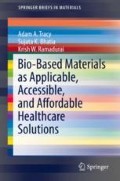Abstract
Biomaterials derived from natural resources have demonstrated significant promise for medical use in the modern era and have steadily been gaining ground in developing countries such as Nigeria. Development of “successful technologies” in the form of natural therapeutics and that utilize bio-based materials could help to potentially lower the barrier to adequate healthcare access and delivery in a multitude of ways. Locally designed and manufactured medical devices and supplies can be fabricated with biomaterials derived from natural, native resources and can be customized to further cater the healthcare needs of the people of Nigeria. Although the initial capital expenditure and investment can be quite high in order to build the infrastructure to support the generation and distribution of biomaterials, the decreased dependence on imported and donated medical supplies, devices, and products could lead to more cost-efficient and sustainable solutions in the future. The true test lies in making the key connections between agriculture, engineering, human capital development, and medicine which is an integral step in improving economic and healthcare outcomes in the future of Nigeria.
Access this chapter
Tax calculation will be finalised at checkout
Purchases are for personal use only
References
African Progress Panel. (2014). Grain fish money. Financing Africa’s green and blue revolutions. Africa Progress Report 2014.
Beine, M., Docquier, F., & Rapoport, H. (2001). Brain drain and economic growth: Theory and evidence. Journal of Development Economics, 64(1), 275–289.
Bhatia, S. K. (2010). Biomaterials for clinical applications. New York: Springer.
Ekebafe, L. O., Ogbeifun, D. E., & Okieimen, F. E. (2011). Polymer applications in agriculture. Biokemistri, 23(2), 81–89.
Helen, C. M. (Ed.). (1991). Nigeria: A country study. Washington: GPO for the Library of Congress.
Juma, C. (2010). The new harvest: agricultural innovation in Africa. New York: Oxford University Press.
Keusch, G. T., Fontaine, O., Bhargava, A., Boschi-Pinto, C., Bhutta, Z. A., Gotuzzo, E., et al. (2006). Diarrheal diseases. In D. T. Jamison, J. G. Breman, A. R. Measham, et al. (Eds.), Disease control priorities in developing countries (2nd ed.). Washington: World Bank.
Meers, P., Neville, M., Malinin, V., Scotto, A. W., Sardaryan, G., Kurumunda, R., et al. (2008). Biofilm penetration, triggered release and in vivo activity of inhaled liposomal amikacin in chronic Pseudomonas aeruginosa lung infections. Journal of Antimicrobial Chemotherapy, 61(4), 859–868.
Ogburn, S. (2010). Fertile ground: The dark side of nitrogen. Grist. http://grist.org/article/2009-11-11-the-dark-side-of-nitrogen/
Olomola, A. S. (2007). Strategies for managing the opportunities and challenges of the current agricultural commodity booms in SSA. Seminar papers on managing commodity booms in sub-Saharan Africa. A Publication of the AERC Senior Policy Seminar IX, African Economic Research Consortium (AERC), Nairobi.
Paul, M. (2013). Northwestern helps bring first biomedical engineering programs to Nigerian universities. McCormick News. Northwestern Engineering. http://www.mccormick.northwestern.edu/news/articles/2013/11/northwestern-helps-bring-first-biomedical-engineering-programs-to-nigerian-universities.html
Reddy, M. M., Misra, M., & Mohanty, A. K. (2012). Bio-based materials in the new bio-economy. Chemical Engineering Progress, 108(5), 37–42.
Shen, L., Haufe, J., & Patel, M. K. (2009). Product overview and market projection of emerging bio-based plastics. Utrecht: European Bioplastics and European Polysaccharide Network of Excellence.
United Nations. (2015). We can end poverty. Millennium development goals and beyond 2015. http://www.un.org/millenniumgoals/
Vink, E. T., Rabago, K. R., Glassner, D. A., & Gruber, P. R. (2003). Applications of life cycle assessment to NatureWorks™ polylactide (PLA) production. Polymer Degradation and Stability, 80(3), 403–419.
Weber, C. J. (2000). Biobased packaging materials for the food industry: Status and perspectives. Frederiksberg: European Union Directorate 12, Royal Veterinary and Agricultural Univ..
World Health Organization. (2006). Country health system fact sheet 2006—Nigeria. Geneva: WHO Press.
World Health Organization. (2010b). Building bridges for innovation across Africa. TDRnews. No.86. Geneva: WHO Press.
World Health Organization. (2013b). Nigeria. Neonatal and child health profile. www.who.int/entity/maternal_child_adolescent/epidemiology/profiles/neonatalchild/nga.pdf
World Health Organization. (2014). Nigeria: Health profile. http://www.who.int/gho/countries/nga.pdf
Mohanty, A.K., Misra, M., & Drzal, L.T. (2002). Sustainable Bio-Composites from Renewable Resources: Opportunities and Challenges in the Green Materials World. Journal of Polymers and the Environment. 10:19.
Glucksberg, M. (2015). Center for Innovation in Global Health Technologies. Northwestern McCormick School of Engineering and Applied Science. Personal Phone Interview. Thursday, February 12th.
Author information
Authors and Affiliations
Rights and permissions
Copyright information
© 2018 The Author(s)
About this chapter
Cite this chapter
Tracy, A.A., Bhatia, S.K., Ramadurai, K.W. (2018). Discussion and Conclusions. In: Bio-Based Materials as Applicable, Accessible, and Affordable Healthcare Solutions. SpringerBriefs in Materials. Springer, Cham. https://doi.org/10.1007/978-3-319-69326-2_4
Download citation
DOI: https://doi.org/10.1007/978-3-319-69326-2_4
Published:
Publisher Name: Springer, Cham
Print ISBN: 978-3-319-69325-5
Online ISBN: 978-3-319-69326-2
eBook Packages: Chemistry and Materials ScienceChemistry and Material Science (R0)

